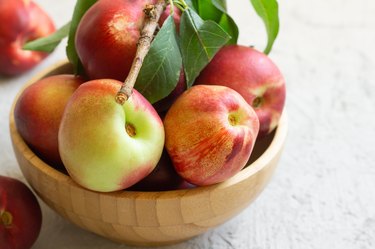
You're browsing through the produce department of your grocery store and, displayed next to the peaches (Prunus persica) are nectarines (Prunus persica v. nucipersica) which you assume are ripe for eating since it's late spring. A search for tangerines (Citrus reticulata), however, leaves you empty. It isn't their season, so you'll have to wait until November to find them on the shelves. There are several differences between tangerines and nectarines. They belong to different families, ripen in different seasons and one requires peeling while the other doesn't.
Classifying Tangerines and Nectarines
Video of the Day
Tangerines are members of the citrus (Rutaceae) family which include oranges, limes, lemons and grapefruit, and they share similar characteristics. The skins are not edible, are peeled to reveal juicy segmented sections separated by a thin membrane, and there is no central pit. The rind is often used for zest to enhance the flavor of foods.
Video of the Day
You can't classify peaches and nectarines as citrus; they belong to the Prunus family. Peaches and nectarines are similar in composition but differ in appearance. Nectarines are smaller than peaches, have a smooth skin that is deeper in color, and the skin is edible. They are a mutation of a peach with an orange, red, pink or yellow exterior and either a white or yellow interior.
Inside is a stone, or a pit, that contains the seeds for reproduction. A ripe nectarine is slightly soft and emits a fragrant and aromatic smell. If you bring home a hard piece of fruit, leave it on the counter at room temperature and out of the sun for a few days until it softens.
List of Citrus Fruits
All citrus have the word "citrus" in their scientific name, such as that found in a tangerine. That doesn't help you at the market, but if you are in doubt as to what a specific fruit is, check it out online. Clementines, tangerines and satsumas all derive from the same Citrus reticulata and are plentiful in the winter months in the United States. Most oranges used for juice and grapefruit are grown in Florida, while California, Arizona and Texas produce the balance of edible citrus.
Citrus deliver a healthy amount of vitamins and minerals to the human body. One orange a day gives the optimum amount of vitamin C needed for a healthy diet. Citrus are also high in fiber which helps lower cholesterol and aids digestion, and they are low in calories. Another benefit of citrus, especially tangerines, is that you can slip one into your pocket and eat it whenever your day allows.
Benefits of Nectarines and Tangerines
Eat tangerines in the winter and wait for spring and summer to supplement your vitamins and minerals with nectarines. Sweeter than peaches, a juicy nectarine fights off diabetes and cardiovascular disease. Nectarines provide twice the Vitamin A and more Vitamin C and potassium than peaches. Just two or more nectarines a week help ward off cancer cells. Plus, they're tasty.
Tangerines, originating in Tangier, Morocco, have fewer vitamins and minerals than nectarines, Eye and skin health is tied to the consumption of tangerines. The thin peel contains an anti-oxidant and has shown to be effective in lowering cholesterol. Use the peels in a compote to make them appetizing.